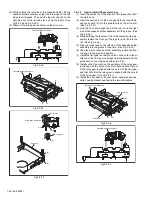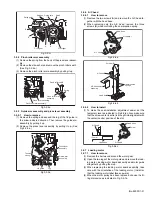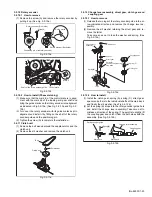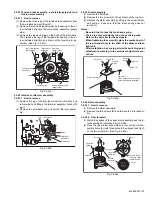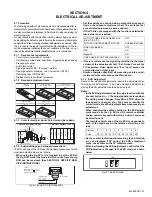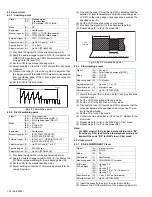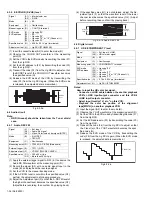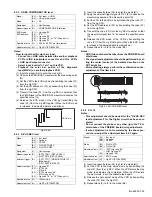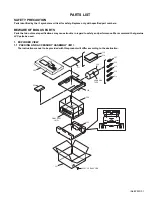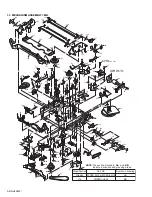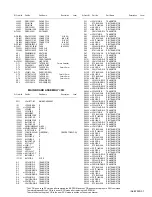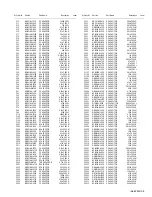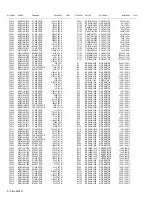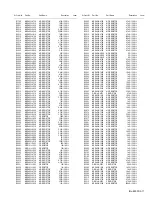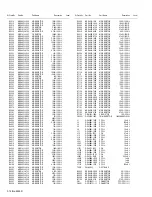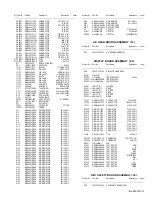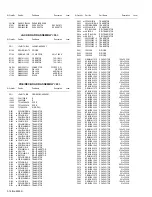
1-34 (No.82933)
4.3.5
EE COLOR (S-VHS) level
(1) Insert the cassette tape (A2) to enter the mode (B).
(2) Observe the COLOR OUT waveform at the measuring
point (D).
(3) Set the VCR to the EVR mode by transmitting the code (F1)
from the Jig RCU.
(4) Set the EVR address to (F2) by transmitting the code (F3)
from the Jig RCU.
(5) Transmit the code (F4) from the Jig RCU to adjust so that
the BURST level of the COLOR OUT waveform becomes
the specified value (G).
(6) Release the EVR mode of the VCR by transmitting the
code (F5) from the Jig RCU again. (When the EVR mode
is released, the adjusted data is memorized.)
Fig.4-3-5a
4.4 Audio circuit
Note:
•
GND (Ground) should be taken from the Tuner shield
case.
4.4.1
Audio REC FM
(1) Apply the external trigger signal to D.FF (E) to observe the
Audio PB FM waveform at the measuring point (D).
(2) Record the signal (A3) with no audio signal input in the
mode (B), and play back the recorded signal.
(3) Set the VCR to the manual tracking mode.
(4) If the A.PB FM level is not within the specified value (G1),
perform the adjustment in a following procedure.
(5) Adjust the Adjustment part (F) so that the A. PB FM level of
the higher channel level becomes the specified value (G1).
(Adjust before recording, then confirm it by playing back.)
(6) If the specified value (G1) is not obtained, adjust the Ad-
justment part (F) so that the waveform level of the lower
channel level becomes the specified value (G2). (Adjust
before recording, then confirm it by playing back.)
Fig.4-4-1a Audio REC FM
4.5 Digital circuit
4.5.1
HD EE COMPONENT Y level
Notes:
How to input the HD color bar signal.
•
Connect an i.LINK cable between the another playback
VCR's i.LINK input/output connector and this VCR's
i.LINK input/output connector.
•
Select input location"I-1 etc." on this VCR.
•
Playback the color bar portion of the alignment
tape[MD-1H] on another playback VCR.
(1) Input the signal (A2) to enter the mode (B).
(2) Observe the Y OUT waveform at the measuring point (D).
(3) Set the VCR to the EVR mode by transmitting the code (F1)
from the Jig RCU.
(4) Set the EVR address to (F2) by transmitting the code (F3)
from the Jig RCU.
(5) Transmit the code (F4) from the Jig RCU to adjust so that
the Y level (a) of the Y OUT waveform becomes the spec-
ified value (G).
(6) Release the EVR mode of the VCR by transmitting the
code (F5) from the Jig RCU again. (When the EVR mode
is released, the adjusted data is memorized.)
Fig.4-3-2a
Signal
(A1)
(A2)
• Internal color bar
• S-VHS
Mode
(B)
• EE
Equipment
(C)
• Oscilloscope
Measuring point (D)
• C OUT (S terminal)
EVR mode
EVR address
(F1)
(F2)
(F3)
(F4)
(F5)
• Jig code “95”
• "00 : **"
• Jig code “20”
• Jig code “18” or “19” (C/-)
• Jig code “3C”
Specified value (G)
• 0.286 ± 0.01 Vp-p (terminated)
Adjustment tool (H)
• Jig RCU [PTU94023B]
Signal
(A1)
(A2)
(A3)
• Ext. input
• Audio: No signal
• Video: Color (colour) bar signal [NTSC]
Mode
(B)
• S-VHS EP
• TBC:OFF
Equipment
(C)
• Oscilloscope
Measuring point (D)
• TP2253 (A. PB FM) [Main board]
External trigger (E)
• TP111 (D.FF)
Adjustment part (F)
• VR2251 (FMA REC LEVEL)
Specified value (G1)
(G2)
• 350 ± 50 mVp-p
• More than 200 mVp-p
BURST
level
Signal
(A1)
(A2)
• Ext. input (i. LINK)
• HD color bar signal
Mode
(B)
• EE
Equipment
(C)
• Oscilloscope
Measuring point (D)
• COMPONENT Y terminal
EVR mode
EVR address
(F1)
(F2)
(F3)
(F4)
(F5)
• Jig code “95”
• "07 : **"
• Jig code “27”
• Jig code “18” or “19” (C/-)
• Jig code “3C”
Specified value (G)
• 0.70 ± 0.02 Vp-p (terminated)
Adjustment tool (H)
• Jig RCU [PTU94023B]
V. rate
Specified
value (G1)
Specified
value (G2)
Y level (a)

